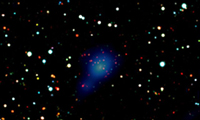- 7 June 2006
Massive galaxy cluster found 10 billion light years away

Faint red galaxies of the cluster in the centre, along with the bluish X-ray emission from the extre
A University of Sussex astronomer is the lead researcher for a project that has led to the discovery of the most distant cluster of galaxies observed to date. The cluster, which is 10 billion light years from Earth, is also likely to be the most massive yet found at such an early era in the Universe.
When Dr Kathy Romer set up the study eight years ago, she thought she was taking a huge gamble. "Although we predicted that we would find clusters at such large distances, we had no guarantees that we'd find any."
Dr Romer, whose team includes Sussex astrophysicist Professor Andrew Liddle and colleagues at other UK and American institutions, used observations from the European X-ray Multi Mirror (XMM) Newton satellite to find this new cluster and then determined its distance using the 10-meter W. M. Keck telescope in Hawaii. "But its not just telescopes that are needed for a project like this,'' comments Dr Romer. "We have also taken full advantage of recent advantages in computing; from new image processing algorithms to the falling price of disk storage."
When viewed with an optical telescope, the distant cluster is revealed as a dense gathering of hundreds of galaxies. "The surprise here is that the galaxies in this cluster are built up from old stars; one would expect that such a distant cluster would be full of new stars, since we are viewing it so far back toward the Big Bang," says Dr Romer. "Clusters like this are vital to our understanding of how galaxies formed."
The cluster, named XMMXCS 2215-1734 is surprisingly massive, weighing approximately 500 trillion times the mass of our sun. Most of the mass is "dark matter," a mysterious form of matter that dominates the mass of all galaxies and clusters in the Universe but cannot be seen by telescopes. Romer and her team are continuing the search for more clusters like XMMXCS 2215-1734 in the XMM-Newton data archive. They already have more than 1000 other candidate galaxy clusters that require confirmation using ground-based optical telescopes. Ultimately they will use their collection of clusters to better understand the physics of the Big Bang.
While the search for more clusters continues, the team will be studying XMMXCS 2215-1734 in more detail, with all the tools available. Already images have been taken by the Hubble Space Telescope of this exciting object. The galaxy cluster is a fossil of the early Universe and, therefore, will be treasured by all astronomers, says Dr Romer.
Notes for editors
Photo available. IImage caption: This colour image shows the faint red galaxies of the cluster in the center, along with the bluish X-ray emission from the extremely hot gas that exists in between the cluster galaxies.
For more information contact Kathy Romer, University of Sussex Physics & Astronomy, +44 (0)1273 877478, romer@sussex.ac.uk
Or Senior Press Officer Jacqui Bealing, Tel: 01273 678888, email: press@sussex.ac.uk
The research team includes:
Adam Stanford (University of California, Davis and Lawrence Livermore National Laboratory)
Kathy Romer (University of Sussex, UK)
Kivanc Sabilri (Carnegie Mellon University)
Michael Davidson (University of Edinburgh, UK)
Matt Hilton (Liverpool John Moores University, UK)
Pedro Viana (Porto, Portugal)
Chris Collins (Liverpool John Moores University, UK)
Scott Kay (Oxford University, UK)
Andrew Liddle (University of Sussex, UK)
Robert Mann (University of Edinburgh, UK)
Chris Miller (Cerro Tololo Inter-American Observatory, NOAO, Chile)
Bob Nichol (University of Portsmouth, UK)
Mike West (Gemini Observatory, Chile and University of Hawaii)
Christopher Conselice (University of Nottingham, UK)
Hyron Spinrad (University of California, Berkeley)
Daniel Stern (Jet Propulsion Laboratory)
Kevin Bundy (California Institute of Technology)
The work was funded by NASA, the Particle Physics and Astronomy Research Council (U.K.), the Hosie Bequest, and the National Science Foundation.